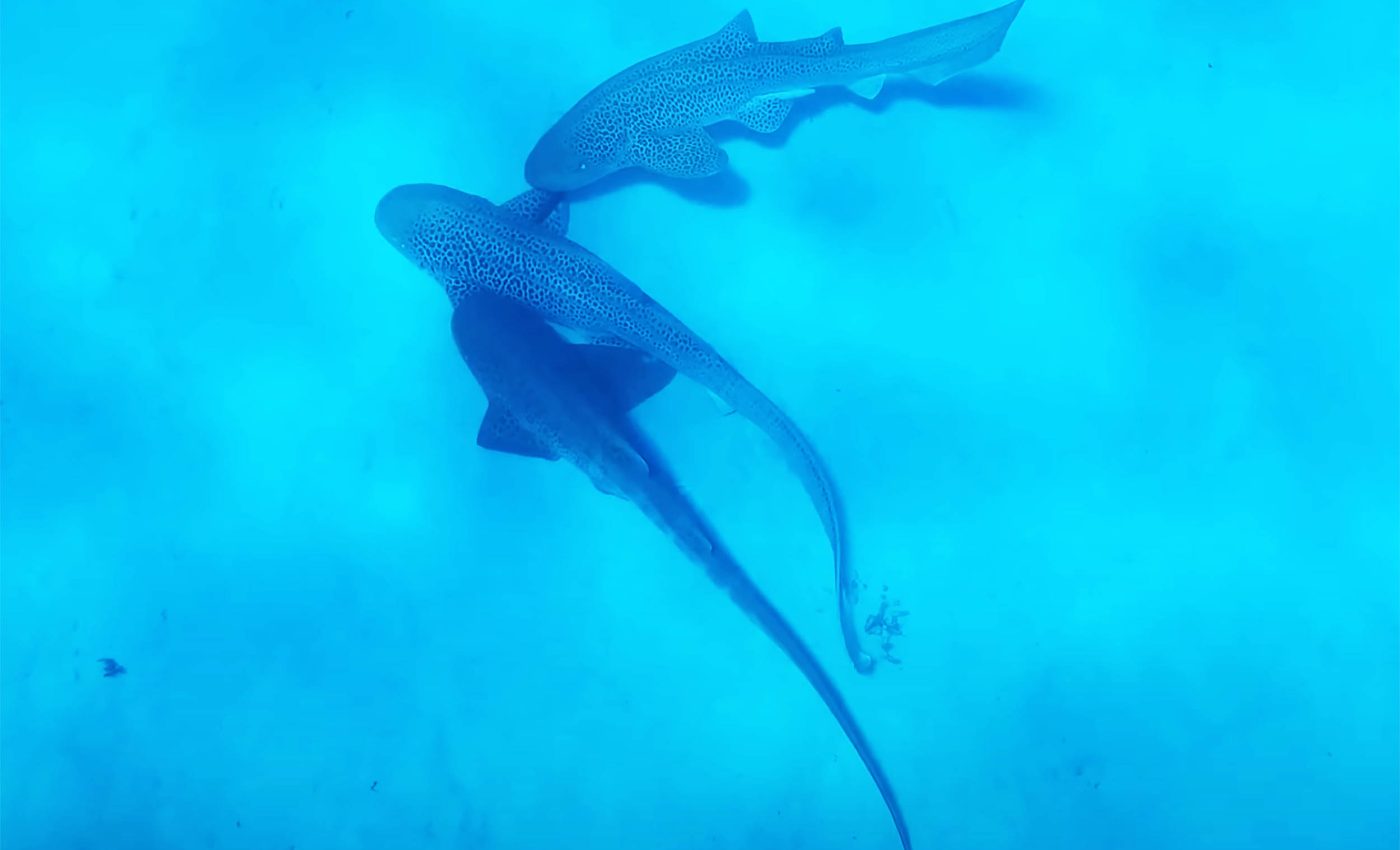
Leopard sharks engaging in a 'threesome' mating ritual captured on video in a scientific first
For years, divers off New Caledonia have watched male leopard sharks dash after females, only to miss the main event. Now we finally have it on film – and it wasn’t just one pair.
In a first for the species, two males sequentially mated with a single female in open water, offering a rare, unfiltered look at how these endangered sharks reproduce in the wild.
The observation comes from University of the Sunshine Coast postdoctoral researcher Dr. Hugo Lassauce, working with Nouméa’s Aquarium des Lagons.
The behavior marks the first scientifically documented sequence of its kind for Stegostoma tigrinum.
The paper is co-authored by UniSC Senior Research Fellow Dr. Christine Dudgeon, Aquarium des Lagons Director and Chief Scientist Dr. Olivier Chateau, and research assistant Hugues Gossuin.
Rare mating ritual revealed
Leopard sharks (also called zebra sharks – pups hatch with stripes that fade to spots) are mostly solitary. Much of what we know about their mating comes from aquariums. Seeing the full choreography in nature has been tough.
Lassauce snorkeled the same offshore aggregation, 9 miles (15 kilometers) from New Caledonia’s coast, every week for a year as part of a monitoring program, hoping to catch the act from the beginning.
“I’d seen males swimming fast after females before, and I’d arrived ‘on the scene’ just after a male and female separated, but I’d never seen the whole sequence,” Dr. Lassauce explained.
“Then, while I was surveying this particular aggregation of leopard sharks, I spotted a female with two males grasping her pectoral fins on the sand below me. I told my colleague to take the boat away to avoid disturbance and I started waiting on the surface, looking down at the sharks almost motionless on the seafloor.”
“I waited an hour, freezing in the water, but finally they started swimming up. It was over quickly for both males, one after the other. The first took 63 seconds, the other 47.
“Then the males lost all their energy and lay immobile on the bottom while the female swam away actively.”
All three sharks were about 7.5 feet (2.3 meters) long. Both males were familiar faces at the site, photographed there as far back as 2018.
Conservation stakes are high
Listed as Endangered by the IUCN, Stegostoma tigrinum ranges across the Indo–West Pacific, from Africa’s east coast to the Pacific Islands, including Australia. Habitat loss, fishing, and trade have driven declines.
That is why any insight into natural reproduction helps. It can guide protections at aggregation sites, refine timing of seasonal closures, and even sharpen assisted breeding programs that aim to “rewild” depleted populations.
The team stresses the scientific value of documenting a full wild sequence – especially one involving two males.
The event was more than a curiosity; it hints at female choice, mate competition, and the possibility of multiple paternity within a season.
“It’s surprising and fascinating that two males were involved sequentially on this occasion,” Dudgeon said.
“From a genetic diversity perspective, we want to find out how many fathers contribute to the batches of eggs laid each year by females.”
Shark conservation breakthrough
Lassauce says the significance hit as soon as he climbed back aboard. The finding was a first for this Indo-Pacific species: two males copulating in quick succession with a single female, recorded from contact to disengagement.
Because the sharks were known individuals, the footage will pair with long-term ID records to explore how often the same males return, and whether particular males dominate breeding opportunities at this site.
The team also notes the post-mating lull. After their brief efforts the males sank to the bottom, inert, while the female powered away.
That pattern echoes captive observations that females regain freedom quickly and may leave the area soon after mating, potentially reducing harassment and injury.
Mysteries of leopard shark mating
One wild sequence can’t settle every question. We don’t know whether both copulations led to fertilization.
We don’t know if females routinely accept multiple males in the same bout, or if this was a high-competition fluke.
But the behavior offers testable hypotheses. Genetic sampling of egg cases and hatchlings could reveal how often multiple sires contribute to a single female’s yearly clutch.
That, in turn, would inform how many breeding males a population needs to maintain diversity.
Lessons from leopard sharks
This study also underlines how much careful patience matters in marine science. The behavior was there all along; it just hid in plain sight, a short sprint after an hour of stillness.
It took weekly surveys, minimal disturbance, and a bit of luck to catch it.
As leopard shark conservation ramps up across the region, such quiet, persistent work will be key – documenting not just who’s present, but what they do when we’re not looking.
Dudgeon, who has studied leopard sharks for more than two decades, says the footage offers rare insight into animals that typically keep their distance from one another – and from cameras.
“It’s surprising and fascinating that two males were involved sequentially on this occasion,” she said. “From a genetic diversity perspective, we want to find out how many fathers contribute to the batches of eggs laid each year by females.”
“I’d seen males swimming fast after females before and I’d arrived ‘on the scene’ just after a male and female separated, but I’d never seen the whole sequence,” Lassauce said.
This time, patience – and a bit of cold endurance – paid off.
The study is published in the Journal of Ethology.
—–
Like what you read? Subscribe to our newsletter for engaging articles, exclusive content, and the latest updates.
Check us out on EarthSnap, a free app brought to you by Eric Ralls and Earth.com.
—–













